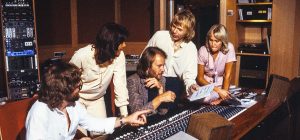IN FOCUS: In The Studio – how the classic ABBA songs were born

ABBA’s many classic hits were the result of intuitive creativity.
Fragments of tunes
“The studio work was the best part of it all: to shape the songs and try to interpret them in your own way.” Those were the words of ABBA’s Agnetha Fältskog, as she looked back on the decade-long series of pop classics that the group gave to the world. “I’ve always felt that the studio work was our strength,” she continued. “That’s where everything came into being – that’s where we created.”
Her bandmates would certainly agree. While some groups may have thrived on the live concert experience, for ABBA the real kick came from using the recording studio as a laboratory, developing and fine-tuning their musical creations. During their active years, this devotion to their art was sometimes held against them, as if there was something wrong in doing everything you could to realise the best version of each and every song. Some even thought that ABBA must be following some kind of formula, calculating how to best “seduce” the unsuspecting public into buying their records. But nothing could be further from the truth: ABBA were feeling their way intuitively through the writing and recording of each and every song.
A waltz or a tango
Everything would start with Björn and Benny getting together with an acoustic guitar and a piano, trying to write songs. In this process they would be throwing fragments of tunes at each other, seeing which of them would fit together, discarding hundreds of melody lines that weren’t good enough.
When the two songwriters had a song they were happy with, it would be brought to the studio. At this stage, the tune didn’t have any proper lyrics, just nonsense words and random English phrases. Often, these phrases would make up the so-called working title for the song: a preliminary name used while work continued on knocking the song into shape. For instance, the working title for ‘SOS’ was ‘Turn Me On’, and ‘The Winner Takes It All’ was originally called ‘The Story Of My Life’ – if you count the syllables, you will see that the working titles are a perfect match for the final titles.
The first step in recording the song was to put together an instrumental backing track. This was recorded with the help of session musicians: usually a guitarist, a bass player and a drummer, with Benny himself playing the piano; sometimes there would also be a percussionist present. Although Björn and Benny always had the final say, they would give the musicians plenty of room to colour the songs. As Benny pointed out, “When you knew that there was the possibility to improve on a song in the studio, with a certain kind of tempo or a guitar riff or whatever, you would only tell the musicians, ‘This is where the song starts now, but we will decide later which parts we will return to, and where the song will end’. That’s the whole point of having good musicians in the studio, to give them room and let them contribute to the arrangement.”
As a part of this process, one and the same song could be attempted in many different kinds of arrangements: it could be a waltz, a disco number, a tango, a rocker – there really was no limit to the styles they would try out. Ultimately, the songwriters would know instinctively when the song had found its final form: the shape it was meant to be in. During this stage, Björn would usually not be playing with the musicians, rather taking on the role of a producer: someone who could have an “outsider’s” point of view and make sure that good arrangement ideas were kept.
What the song is saying
Once a backing track was in place, a rough mix of the song would be made and copied onto a tape. This tape was then taken home by Björn, for now it was time for him to write the lyrics. This was crucial: instead of bringing a song to the studio with finished music and lyrics, the final words were only written when the instrumental backing track was completed. This was because the musical arrangement was such an important part of the song’s identity, so it was through listening to the backing track that Björn extracted the message of the song. “I wanted there to be some kind of ambience in the recording,” he explained, “because then I would get a clearer picture of what the song was ‘saying’. There was more pleasure in hearing a really great backing track, rather than listening to some tape of me and Benny banging away on a piano and acoustic guitar. It just wasn’t as inspiring.”
With the lyrics written, Agnetha and Frida would come to the studio to add the magic of their vocals to the recording. As Benny once pointed out, the ladies’ voices were the most important ingredient of the group’s sound, the factor that made it sound like ABBA. And although it would be easy to conclude that everything concerning the vocals had already been decided by Björn and Benny when the female half of ABBA came to the studio, this was not how they worked. On the contrary, Agnetha and Frida were both active participants during the recording process, coming up with their own ideas for how to sing the songs and contributing ideas for harmony parts.
“Creativity is something that works really well when you’re in a studio environment,” noted Frida at one point. “We’d sing along to the piano or sometimes to the tape with the backing track. When you kept hearing the melody over and over, and you’d be working on it, other things would emerge, like little choir bits or a ‘response’. You’d say, ‘This bit here I think sounds good, it feels good’.” Nor were they afraid to speak up if some of the lyrics were awkward to sing – that is, if the combination of consonants and vowels in words or phrases just didn’t sound good when sung. Then it was up to Björn to adjust the lyrics. So, in much the same way that Björn and Benny welcomed input from the backing musicians, they were only happy to have this creative dialogue with the female half of ABBA – they all wanted the same thing: to make a really good recording, making sure that each song was the best it could be.
Never stuck on the vocals
Agnetha and Frida would start their day in the studio by acquainting themselves with the song, after which they began the actual recording with the backing vocals and all the intricate harmonies. The lead vocals were saved for last, for by that time they had found their way into the song and were better able to deliver an emotional interpretation of the tune. The recording of the vocals would only take one day, including multiple overdubs of choir parts. This sounds incredible, but, as ABBA’s engineer Michael B. Tretow once pointed out, “Agnetha and Frida somehow seemed to be cut out for this job. We almost never got stuck on the vocals”.
The final part of the recording process was further overdubs and mixing. This was usually a parallel process, because it was only when the control room trio of Björn, Benny and Michael Tretow sat down at the mixing desk that the ideas for the overdubs emerged. The overdubs usually took the shape of ideas for keyboard riffs, emanating from Benny’s brain and played on synthesizers, pianos or any other keyboard-like instrument.
After at least a week of hard work, a brand new ABBA song had finally been completed, ready to be released and storm up the charts across the world. That is, if the group were happy with what they’d accomplished. For sometimes their gut feelings would tell them, “this song has a lot of potential, but we’ve recorded it the wrong way – we can’t release this”. And so, the entire process would start over again…
